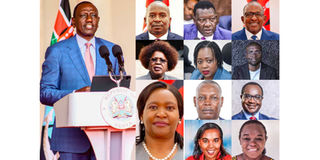Hello
Your subscription is almost coming to an end. Don’t miss out on the great content on Nation.Africa
Ready to continue your informative journey with us?
Hello
Your premium access has ended, but the best of Nation.Africa is still within reach. Renew now to unlock exclusive stories and in-depth features.
Reclaim your full access. Click below to renew.
Timeline: The rise and fall of women's representation in Kenya’s political leadership since 2022

President William Ruto (left) and his first batch of Cabinet nominees.
By Moraa Obiria
Senior Gender Journalist
This timeline has been created using data compiled from the official records of the Independent Electoral and Boundaries Commission, the Kenya Women Parliamentary Association, and Presidential appointments.
General election
During the general election, Kenyan voters elected 29 women as Members of Parliament (MPs) representing single constituencies, an increase from 23 in 2017.

Cabinet nominees
President William Ruto announced his Cabinet nominees. Among them was Alice Wahome, who had been elected as the Kandara MP, appointed as Cabinet Secretary (CS) for Water, Sanitation, and Irrigation. In the by-election that followed, a man was elected to replace her. Consequently, the number of elected women legislators in the National Assembly dropped to 28.
At the same time, President Ruto backtracked on his commitment to a gender-equal Cabinet, appointing only seven women as CSs.
Fresh Cabinet appointments
President Ruto made fresh Cabinet appointments after dissolving it in response to deadly anti-finance bill protests led by Gen Z activists. While he retained some of the previous CSs, one of the new appointees was Stella Lang’at, nominated for the Gender docket.
Rejected by committee
Stella was rejected by the National Assembly Committee on Appointments for failing to demonstrate an adequate understanding of the Gender docket.

Mini-Cabinet reshuffle
President Ruto conducted a mini-Cabinet reshuffle, which led to the removal of ICT Cabinet Secretary Dr Margaret Ndung’u. She was replaced by former Kiambu County Governor William Kabogo. Dr Margaret was reassigned as Kenya’s High Commissioner to Ghana, a position she declined.
Her removal reduced the number of women CSs to five. Additionally, the vacancy in the Gender docket remained unfilled, marking a significant decline in women's representation in the executive arm of government. The acting Gender CS is also a man, the Prime Cabinet Secretary Musalia Mudavadi.

Political agreement
President Ruto entered into a political agreement with ODM leader Raila Odinga after Odinga lost his bid for the African Union Commission chairperson seat in Addis Ababa. This occurred as the UDA and ODM parties punished members who had supported the impeached Deputy President Rigathi Gachagua by removing them from leadership positions in parliamentary committees. These changes affected women’s leadership in Parliament.
Before the changes, four of the 25 audit, appropriations, and other select committees were led by women legislators. However, following the reshuffle, Gathoni Wa Muchomba (Githunguri MP) was removed as chairperson of the Constitutional Implementation Oversight Committee, reducing the number of women-led select committees to three.
Impeachment of Meru Governor Kawira Mwangaza
At the same time, the High Court upheld the impeachment of Meru Governor Kawira Mwangaza, ruling that the process leading to her removal was lawful. Consequently, the number of elected women governors fell from seven to six, despite earlier celebrations over the increase from three in the 2017 general election.
Illustrated by Geoffrey Onyambu


